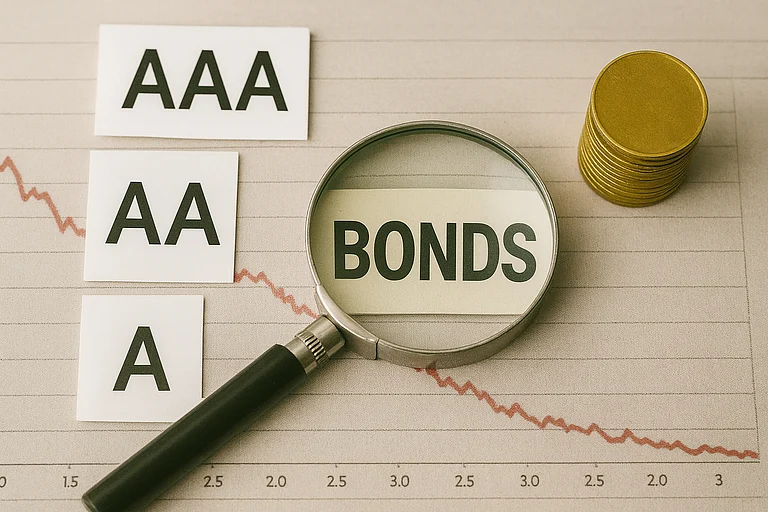In India, the bond market is mostly dominated by big institutional players like mutual fund houses, insurance companies, banks, pension funds and trusts. Retail investors, on the other hand, still do not participate actively, partly due to a lack of knowledge, high minimum investment requirements, and limited products for retail investors among many other issues.
Bonds can be used as alternative assets for diversification of portfolio, which generally offers stable returns with lower risk compared to equities.
How Bond Market Works?
Bonds are debt instruments issued by governments and corporations to raise funds. By buying a bond, investors are lending money to the issuer for a fixed period of time.
On the buying amount, the investor earns interest on a periodic basis, known as coupon investments, until the bond matures. At maturity, the investor gets back the initial investment amount.
Types Of Bonds
While there are several types of bonds in the Indian bond market, they can broadly be classified into two categories based on the issuer – government bonds and corporate bonds.
Government Bonds – Government bonds, as the name suggests, are issued by central government or state governments. These types of bonds form the bulk of the Indian bond market as they are considered extremely safe. Within government bonds or G-Secs, there are several sub-categories such as fixed-rate bonds, floating-rate bonds, sovereign gold bonds, inflation-indexed bonds, and zero coupon bonds among others.
Corporate Bonds - Corporate bonds are issued by corporations or companies. These types of bonds are generally considered riskier than government bonds as the company issuing the bonds needs to make enough revenue and profit to pay interest to bondholders. However, since a company's ability to generate revenue may depend on external factors that are beyond its control, this makes corporate bonds riskier.
Who Should Invest In Bonds?
Vishal Goenka, CEO & Co-Founder of IndiaBonds, says, "Bonds are suited well for investors prioritising stability, fixed returns, and portfolio diversification. They are particularly great for conservative investors, senior citizens, and high-net-worth individuals seeking capital preservation with lower volatility than equity."
Given the current uncertainties in the equity market and interest rate movements, bonds—especially tax-free and highly-rated corporate bonds—provide steady income and preserve capital. Given the current uncertainties in the equity market and interest rate fluctuations, bonds—particularly tax-free and highly-rated corporate bonds—offer steady income while safeguarding capital, Goenka says.
Things Investors Should Consider When Buying Bonds
Goenka advises investors to assess the yield-to-maturity (YTM) of bonds, as it reflects actual returns based on current market prices, rather than just focusing on the stated coupon rates. Credit rating and issuer reputation are critical to assess default risk and bond reliability, he says.
Goenka also suggests that investors should align bond maturities with their investment horizon and consider market liquidity for easier transactions. He adds that it's important to stay updated on macroeconomic trends, interest rate changes, and regulatory developments, as these directly impact bond prices and yields.
Risks Associated With Investing In Bond
Nikhil Aggarwal, Founder & Group CEO of Grip Invest, highlights three main risks that come with investing in bonds.
The first is the credit risk, which is the risk that the company issuing the bond will be unable to fulfill its promise of paying timely interest and returning the principal to investors. "To help investors understand this risk, every regulated bond carries a Credit Rating from a SEBI-regulated rating agency like CRISIL, ICRA, CARE, or India Ratings. The safest of bonds are rated 'AAA', while all bonds rated 'BBB' and above are considered to be of investment grade. On account of a strong regulatory environment, a robust security package provided in each bond, there have been very few defaults in corporate bonds in India," Aggarwal says.
The second risk is liquidity risk, which is the inability to exit the bonds before the maturity period as they may not be actively traded. However, Aggarwal points out that with the rise of online bond platforms, this issue has been partially addressed.
The last one is interest rate risk. Rising interest rates can lower the value of initial investment. However, Aggarwal, points out, investors who are looking to hold the bond to maturity do not need to worry about this risk as they will keep earning the expected yield on the bond.
How To Invest In Bond Markets
Investors can purchase bonds via the following means:
Primary Market: The Reserve Bank of India (RBI) periodically conducts auctions when new government bonds are issued. Investors can participate in these auctions through a bank or a main dealer, where they can place bids by specifying how many bonds they want and the price (or yield) they are willing to pay.
Secondary Market: Investors can also buy and sell existing government bonds in the secondary market through banks, stock exchanges, or other authorised platforms. This market provides liquidity, meaning bonds can be traded at current market prices.
Non-Competitive Bidding: For retail investors who may not have the expertise or resources to bid competitively in auctions, non-competitive bidding is an option. In this case, investors don't specify a price or yield but are instead allocated bonds at the weighted average price set during the auction.
Mutual Funds and ETFs: For those seeking a more diversified and professionally managed way to invest in government bonds, mutual funds and exchange-traded funds (ETFs) are good options. These funds pool money from multiple investors, and professional fund managers handle the investments.














